Rangoli is an art form that is prominently known for its cultural and historic significance in India. History of rangoli, importance of rangoli and its scientific reason finds its roots in the Vedic and ancient times of India. It is an intrinsic part of Indians’ life so much so that no festival or prominent life occasion here happens without this beautiful and captivating art form.
During festivals, they don a grandeur form and amp up the beauty of already beautiful Indian homes. As we move on, we shall delve deep into the various aspects of this beautiful Indian floor art. We have also included tips to draw rangoli easy and many types of rangoli designs with dots and without dots.
Quick Navigation
History of Rangoli
Rangoli finds its roots in the Vedic times of Hinduism. Also, according to many researchers, this art form dates back to the times of the caveman era.

Researchers found that early man in the prehistoric times believed that the five elements influenced every way of human life:
- Fire
- Water
- Air
- Soil, and
- Space
To protect themselves from the evil and negative energies, early humans used to draw intricate patterns in geometric shapes to attract positive cosmic power.
Many designs found in the Indus Valley and Harappa regions provided proof that earlier civilizations also used such designs in various forms. While some symbolized Talismic energies, others were used as a form of protection of homes and villages from negative energies.
The modern designs have many straight lines and modern shapes. The first forms predominantly contained the elements of nature such as the Sun, Fire, trees, birds, animals, and flowers. Motifs like Swastika, crosses, circles, snakes, and Goddesses existed in cave form paintings in ancient India. One can find their usage in the modern-day designs too.
Vasudhaiva Kutumbakam: The Timeless Philosophy of India’s Global Harmony
Mention of Rangoli in Ancient Indian Scripts
The mention of this art was made in many significant ancient scripts of India.
Natyashastra, for instance, the Sanskrit treatise for the Indian arts, drafted by Bharata Muni, mentions them. This scripture was drafted during the period of 200 B.C. to 200 A.D. As per this book, before artists performed an art on the stage, one symmetrical mandala adorned with colors and flowers was drawn on the stage. Then the Gods were worshipped and invoked to occupy their places on the Mandala.
Even today, when beginning a traditional puja or worship, it is a common practice according to Indian philosophy to draw a design of an eight-petaled lotus flower on a cleaned wooden platform. It is decorated with turmeric, flowers, and vermilion, and Gods are worshipped and invoked.
Mention of Rangoli in Ancient Hindu Texts
The holy epics of Ramayana, Bhagavata, and Mahabharata have mentioned the prominence of this art in various instances.
Mention of Rangoli in Ramayana
The story of Sita Mata being kidnapped by Ravan is well known to most of us. Before leaving her Sister-in-Law unprotected and alone in the hut in the forest, Lakshmana draws a circle of power around the hut and asks Sita Mata not to cross it and come outside. But Sita Mata unintentionally crosses it and the rest is history.
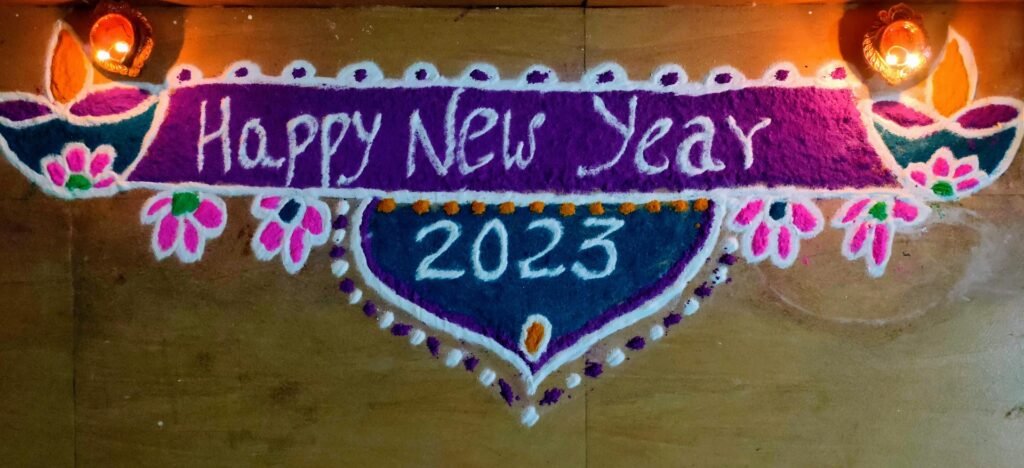
According to folk tales, this circle that Lakshman draws is a form of Rangoli with divine powers. According to Ramayana, Lord Rama killed Ravan at Dasara and Return to Ayodhya with Sita Mata on Diwali.
Also, in Sundarakanda, where the description of Lord Vibhishana comes up, the mention of this art in his kingdom and their beauty emerges.
Mention of Rangoli in Mahabharata
The story about Subhadra And Lord Krishna tell the importance of this visual art.
Once, in the land where Subhadra, the sister of Lord Krishna resided, there was a celebration on an Ekadashi day that needed the playing of drums and Tabor.
It so happened that the cover of the drums and the sticks of tabor was damaged. The king ordered that whoever did not follow the Sankha Chakra Gopadma ritual on that year shall be deskinned and their skin be used as the covering of the drum. Their bones shall be used as the sticks of the tabor.
Everyone in the town, except Subhadra, performed this ritual that year. Struck with fear and guilt, she ran to her brother’s help.
Lord Krishna then suggested she clean the house and the cowshed, draw beautiful patterns of a swastika, Sankha, Chakra, Gada, Padma, leaves, flowers, sugarcane, etc. on the cleaned floor and decorate them with flowers, precious stones, and powdered gold and silver.
Sri Krishna also instructed her to draw a cow shape on the floor and fill the stomach place with 33 lotus flowers and worship it and circumambulate it 33 times. He assured that by doing these with devotion, she shall be freed from the sins of not performing the ritual and also can be freed from the punishment. It is still this practice of GoPadmavrata that is practiced in Maharashtra.
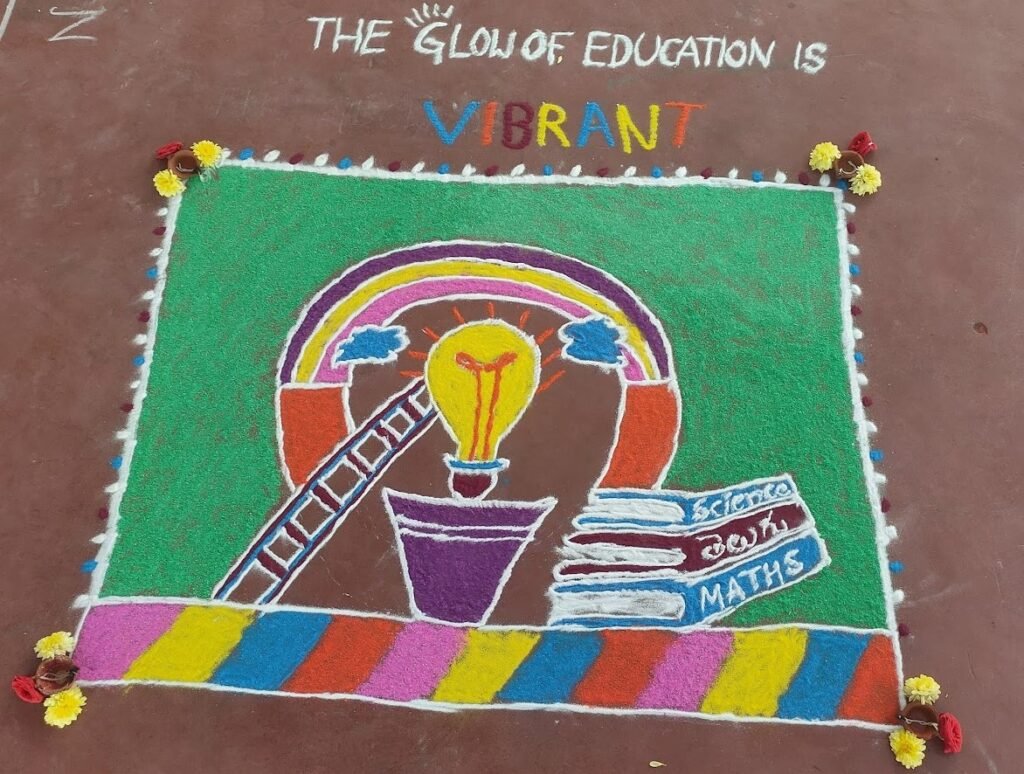
Mention of Rangoli in Bhagavata
Gopikas were ardent worshippers of Lord Krishna. They breathed and lived Krishna at every moment.
It was once when Sri Krishna went out of the town, Gopikas missed him intensely and started to draw his exact form on a clean surface and decorated it with colors and flowers.
They used to see him in that art form and thus used to feel that Krishna was with them all the time.
The magnificence of Ayodhya Ram Mandir
The Birth of Urvashi Story
According to the scripture Vishnudharmottara, when Sage Narayana was deeply in penance, the apsaras began to appear in front of him to distract him. Angered sage wanted to give a lesson to the apsaras and drew the shape of a beautiful woman from the juice of the mangos from the trees nearby.
On seeing the beauty of shape, the apsaras felt ashamed and left the place. The sage gave life to that beautiful shape of women, who was none other than the Apsara Urvashi. Makara Sankranti Rangoli Designs
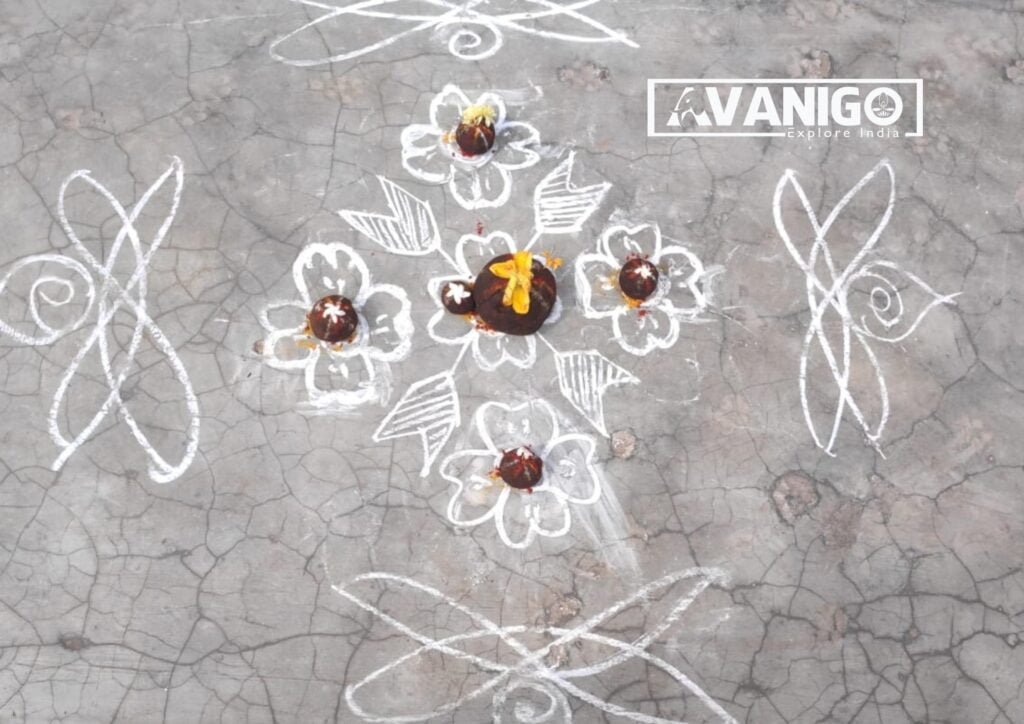
The Legend of Chitra Lakshana
Once upon a time, there lived a priest and his son in a kingdom. They both were highly revered and respected by the whole kingdom, including the king. Unfortunately, the son of the priest died and the whole kingdom was left in grief. They started praying to Lord Brahma, the Creator of the Universe.
Lord Brahma who was astonished at their love towards the son of the priest, appeared before them. He instructed them to draw the picture of the priest’s son. The people abided by his instructions with devotion and drew exactly the portrait of the son using natural colors and flours on cleaned land.
Lord Brahma then gave life to the portrait and brought back the son to life. It was then the people started drawing portraits and shapes in front of their homes to please Gods for happiness.
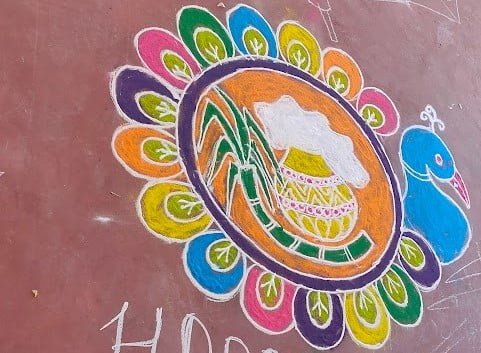
Relation between Rangoli and Margazhi month
These hindu art designs are given immense prominence especially in the month of Margasira. In Tamilnadu, this month is revered and dedicated to the worship of Lord Vishnu and Andal Amman.
The story behind Andal Amman and Lord Vishnu is well known. In the 8th century, there was a devotee of Lord Vishnu in the region of Tamilnadu. He had no children for long and prayed immensely for a baby. Then, by the grace of Lord Vishnu, he was gifted with a daughter.
Daily during the worship of Lord Vishnu, her father would ask her to weave flower garland for the same. This little girl, with innocence, used to weave the garland and wear it and test it for length and fragrance before submitting it for worship.
One day, her father found a hair strand in the garland and came to know about her practice. He was upset with guilt as it is a sin to offer to God what we have tested and tried. But Lord Vishnu appeared in the dreams of Vishnuchitta and consoled that those garlands are acceptable for him.
The girl, at the age of 15, used to consider Lord Vishnu as her husband and prayed for him during the month of Margasira (the month of Mid December to Mid-January). Thus, she was considered as the girl who was known to gain the heart of Lord Vishnu.
Thus, it is a norm for unmarried girls to wake up early during Margasira and adore their house fronts with beautiful designs in a wish to obtain good husbands. A good rangoli design is a symbol of Goddess Lakshmi and is worshipped as her other form.
The Thiruppavai is a Tamil devotional poem attributed to the female poet-saint Andal a manifestation of Lord Vishnu). India vs Bharat: The Significance of the Name Bharat
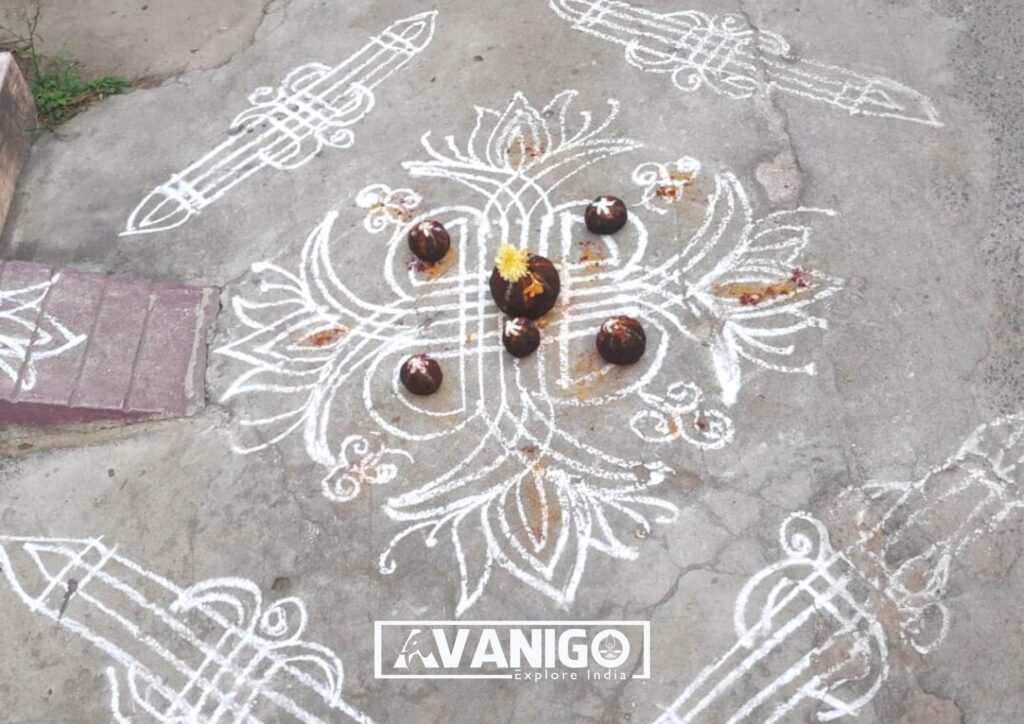
Scientific reason behind Rangoli
Rangolis are intrinsic lines and shapes drawn with immense talent and attention. The secret in drawing rangoli designs easy is in their drawing lies in the joining dot to dot without any breakage or deformation of the symmetry and the shape.
A closer look at the science behind rangoli reveals many intriguing facts. Modern science proved that geometric patterns can evoke positive vibrations. The study of such science behind the patterns, Cymatics, proved that there is immense science hidden behind the designs drawn by Hindus in front of their houses.
If one has noticed traditional designs, some patterns appear frequently. There is a hidden scientific reason behind Rangoli with dots.
For example, the curved patterns that join the dots symbolize the infinite nature of the universe. Such patterns also resemble the wave harmonics of the sound. The world has already recognized the potential of sound waves in treating many ailments including depression and mental disorders.
Thus, the scientific reason behind Rangoli implies that these art designs are visual sound and energies.
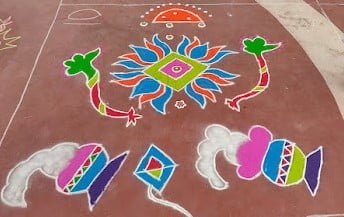
Why Indians draw Rangoli?
When one crosses such geometric patterns in front of the house while entering the house, their negative energies get disseminated and they enter the house with positive vibrations. Similarly, when one sees the freshly drawn designs before heading out to work in the morning, they can get the energy that drives them throughout the day.
This is the reason why Indians draw Rangoli. And also, why orthodox families of India believe that it is important to draw them in front of the houses before their men head out to work in the morning.
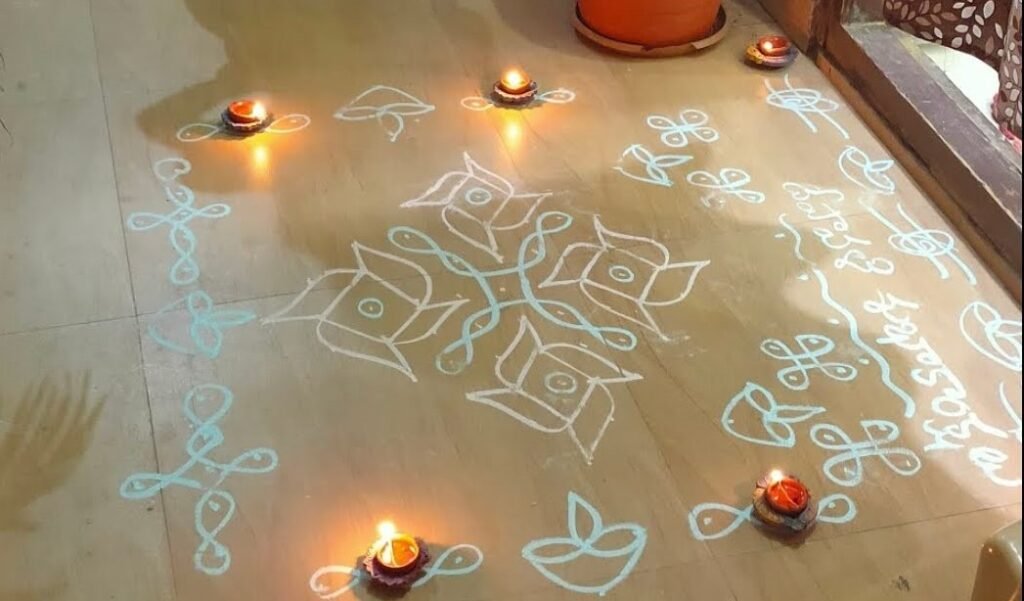
Another reason why Indians draw Rangoli is when guests enter the house with beautiful designs, their spirits will be boosted and they find a warm welcome as they enter our house.
Talking about the science behind rangoli, according to Neuro-science, the impact of visual patterns on the mind is drastic. They can hit the neural circuitry, imbibe positive emotions, and stimulate the brain. Various researchers who gave their talks on this topic at TED talks and neuroscience researchers stressed the positive energies of these art forms.
The spiritual significance of Rangoli
There are various types of rangolis that are drawn in different patterns. The scientific reason behind rangoli is that they can evoke many spiritual experiences. Each of the different types of Rangoli has its scientific reason and spiritual meaning behind it.
- The lines forms that are usually drawn in Southern India and Tamilnadu are known to boost the Bhav emotion of spirituality.
- The Lotus forms that are drawn before the start of pujas and worship are known for their Chaitanya or energy evoking.
- The designs in symmetry and square-shaped are proven for their energies that cause Ananda or bliss in humans.
The underlying principle behind rangoli is called the Divinity principle. It imparts related spiritual feelings to the devotees and people around the design. The Sri Chakra, the ultimate powerful yantra of Hinduism is also the form of rangoli that contains immense cosmic power.
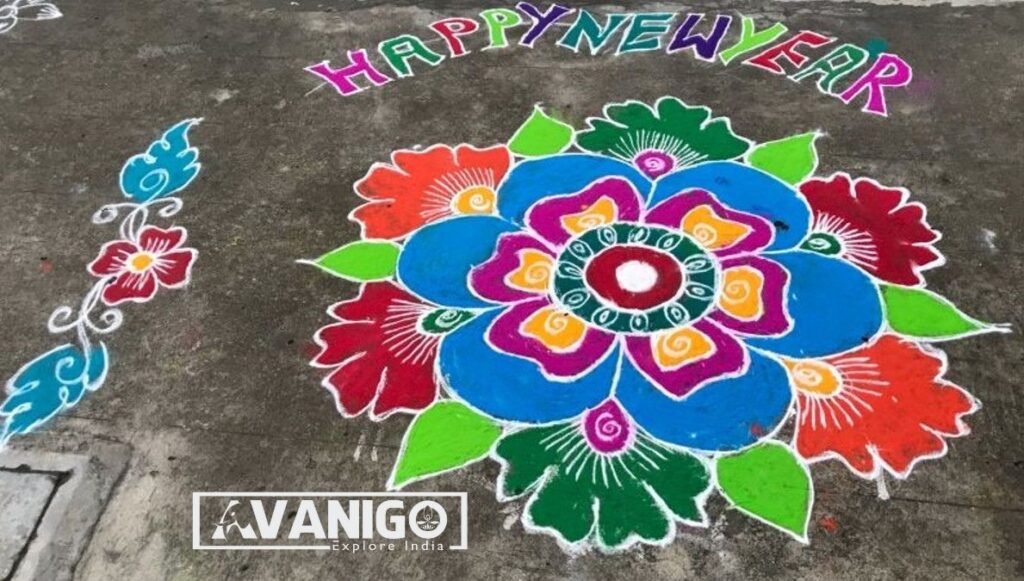
Rangoli practice in India
Rangolis are also called Kolam in South India. India is known for its amazing cultural habits that have many hidden secrets in strengthening social and cultural bonds. They are mainly known to be the arena of women.
Women used to get up early before the sunrise and clean the house fronts with water. In some villages and remote places, people sprinkle the water mixed with cow dung. Once the water dries, they start drawing beautiful patterns, without any gaps or breakages while joining the dots.
Science behind Rangoli
- Rangolis are usually drawn with rice flour or rice powder. They serve as food for insects and birds. Thus, there lies a message that we should care for other living beings on this Earth.
- To draw kolams, women get up early before dawn and do their work. This habit of waking up before the sunrise makes them healthy and wise.
- Hindu texts always gave enough proof to depict the greatness of women in designing and guiding their family and children. Drawing kolams in the early morning is a way to strengthen a woman both physically and spiritually.
- When drawing kolams, proper care is taken not to bring out any breakages or distorted forms in the designs. Most women would never accept a distorted shape as rangoli and will think no more to clean the whole place again and start afresh. This is because any breakages or distorted forms attract evil energies that are present in the space.
- While positive and symmetric forms are a way to invite Gods and positive energies. Therefore, while drawing kolam, immense care is taken to see that the shape is symmetric with no gaps of any sort. This care is taken even while filling the colors too for the same reason.
- When women draw kolams and fill colors, they do not use any tools except fingers. This is a form of Mudra technique that helps boost the spiritual stamina of women.
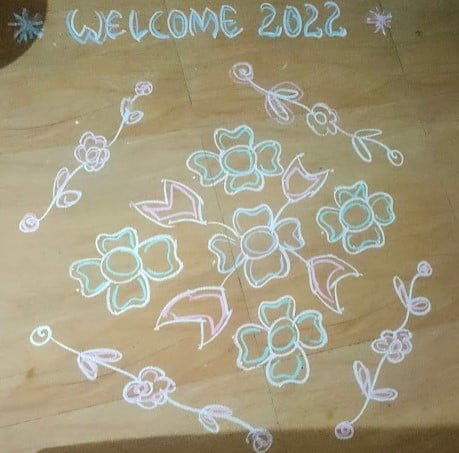
Social and Cultural Significance of Rangoli
Women usually pair up to draw bigger kolams during festivals and occasions. This strengthens their bonds. Also, they plan carefully for the design, the colors to be filled, and try to bring out their best rangoli beating the other women in the locality. This is a healthy way to imbibe sportiveness and strengthen the cultural bonds among women.
In many Indian families, kolams are a lot more than just art forms. Every family will have its designs that are being passed on from generations to the next. Some families never reveal the secrets behind how they draw so intricate patterns with ease and perfections. They take it as their cultural pride and only pass the secrets to their daughters and daughters in law who are socially their heirs.
Diwali Rangoli designs
The drawing of kolam changes from occasion to occasion. While for modern festivals like New Year, the designs reflect joy and happiness, for festivals like Dussehra and Diwali, the designs vary and reflect the occasion. This is why we find many unique Diwali rangoli designs, Sankranti rangoli designs, and Dasara rangoli designs all separate and different from one another.
While Diwali designs have diyas and traditional patterns in them, Dussehra designs come with Durga Mata and her power symbols. In Sankranti designs, you can see the inclusion of kites, Pongal pots, Sun, farmers, harvest, etc in the designs. On similar lines, many festivals will have their unique designs.
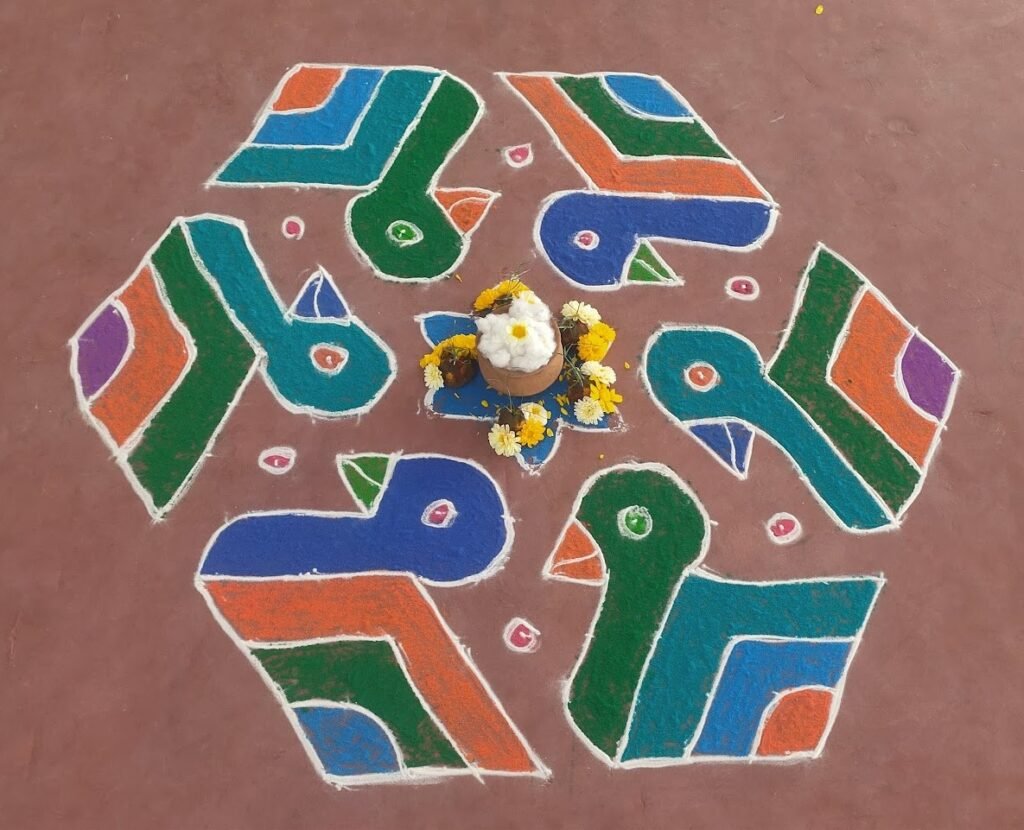
How did the name rangoli originate?
The name Rangoli originated from the term Rangavalli of Sanskrit. Rangavalli means creepers in beautiful colors. Thus, this rangavalli slowly transitioned into the term that is widely in use now.
What is rangoli called in different states of India?
Though the origin and the practice are the same, rangoli is called with different names in various states of India.
- Andhra Pradesh – Muggu
- Bihar – Aripana
- Chhattisgarh – Chauk Purna
- Gujarat – Sathiya
- West Bengal – Alpana
- Karnataka – Rangavali
- Kumaon region of Himalayas – Aipan or Alokathap
- Tamilnadu – Kolam
- Rajasthan – Mandana
- Orissa – Osa
- Kerala – Poovidal or Kolam
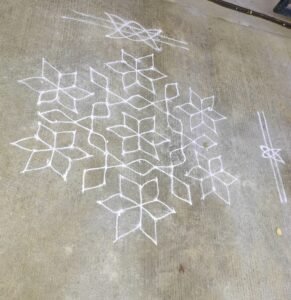
Tips to draw rangoli easy
The floor is first cleaned before drawing the design. The cleaning is done usually with water or wet cloth depending on the type of the floor. Then designs are drawn with chalk pieces, muggu rayi, chalk powder, rice husk ash, rice powder, or rice grains, flowers, etc. depending on the local traditions. During Diwali times and also on special occasions, people decorate muggulu with oil lamps.
- First clean the floor so that there are no impurities and stones, etc.
- Then sprinkle water to make it wet. If the floor is granite or concrete or cement-based, you can mop with a wet cloth to make it wet.
- Draw a basic outline with powders or chalk pieces.
- When using powder, take a little amount of muggu powder in between your thumb and forefinger. Slowly release the powder and draw the design without any breakages.
- Start filling the colors from the center of the muggu and coming towards the outer edges. This way you will lessen the chances of design damage and color mix mishaps.
- Ensure that colors are filled in every column and shape and there are no gaps towards the borders.
- Once the whole design is filled with colors, give a second outline with powder or chalk once again to give the kolam a comprehensive look.
- You can add smooth sand, salt, or muggu powder into colors to make them flow freely while filling the colors.
- Some people also fill the shapes and muggu with wet colors mixed in water.
- Whatever the form you choose, it is best to practice the design on a paper and color filling technique before you draw on the big day.
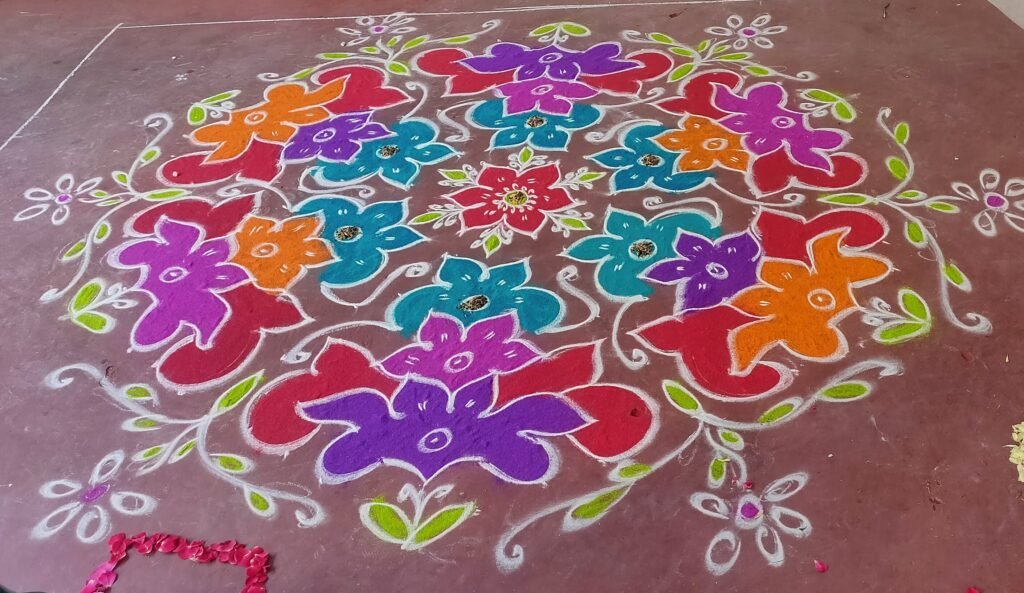
Where should you draw rangoli?
They are primarily drawn on the floor that welcomes one into the house such as verandahs and in front of the gates. They are also drawn in backyards at Tulasi Kota, and in the central portion of the house as per Vastu. People also draw muggulu or kolams in the puja rooms and kitchen platforms. They can be drawn anywhere as per Vastu to invite positivity and good energy.
When are rangolis not drawn?
In India, people do not draw rangoli during mourning. Thus, for a house to not have rangoli on normal days signifies a bad omen and inauspicious.
Latest Rangoli designs
India has been protecting this kolam culture with great care. One can witness muggulu competitions in colleges and schools especially on occasions like on teacher’s day celebration which is a great way to teach their significance to the next generations.
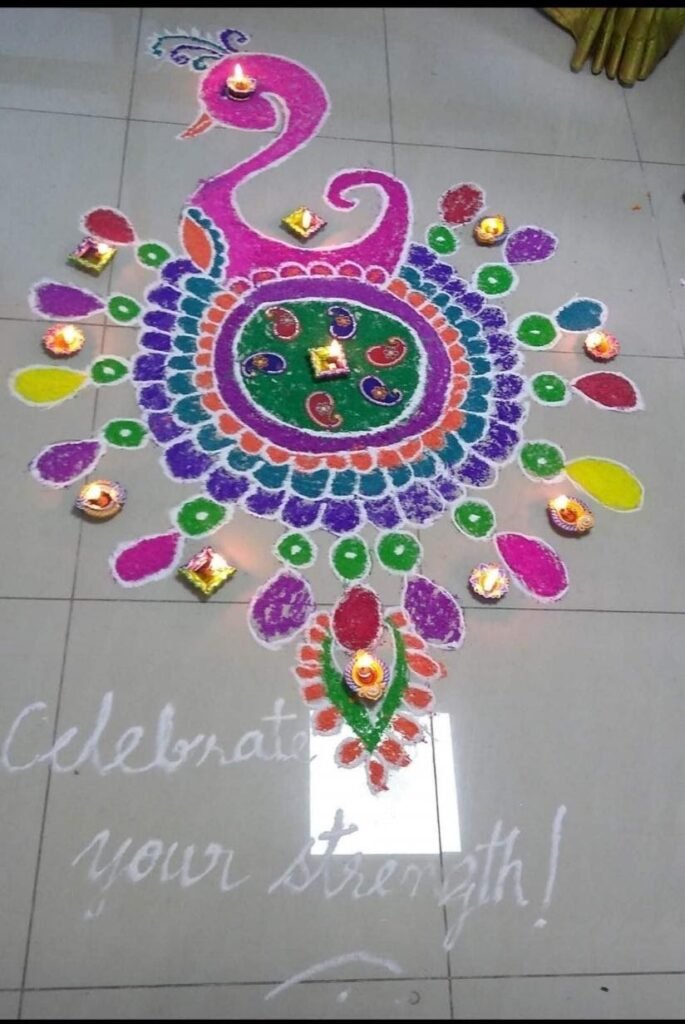
Latest rangoli designs are drawn to reflect the social practices, achievements, and any other themes that can be conveyed using the art form. Kolam or muggu is thus a way of expressing a topic with visual impact too.
Latest rangoli designs are drawn using many devices such as stencils, tubes for color filling, etc. This is a good way to modernize the artform. However, the secrets behind their practice should be taught to the children so that they appreciate cultural practices.
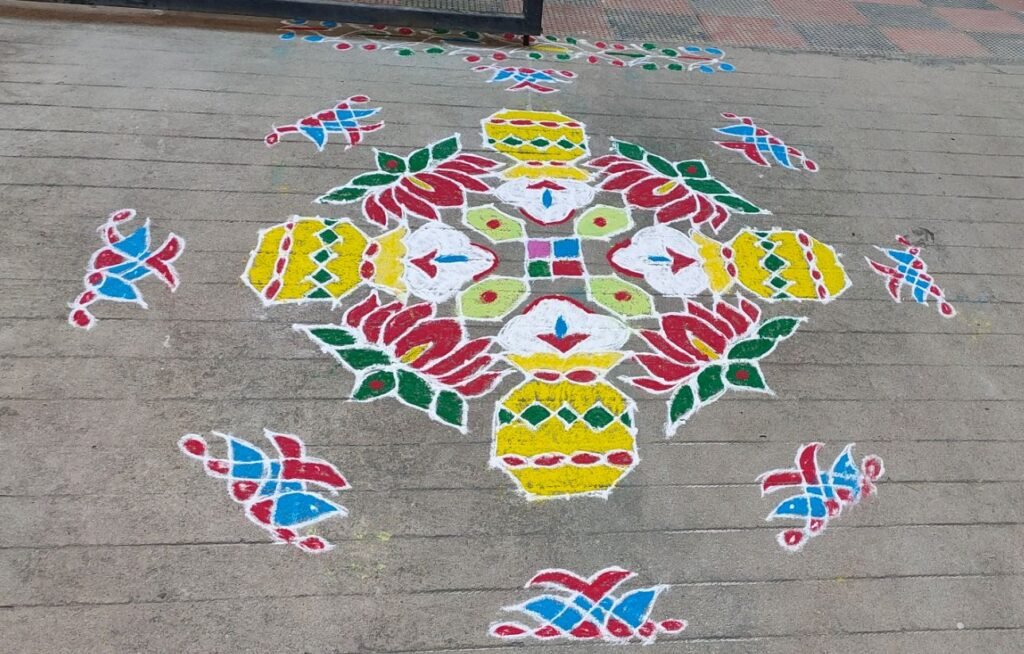
What countries are Rangoli designs popular?
This practice has been in existence in many countries in various forms. For instance, in Africa, Australia, etc. there were proof that their ancestors used to practice this art for various reasons. However, it is in India that this practice is still in use and that is what is making this culturally rich land more beautiful!
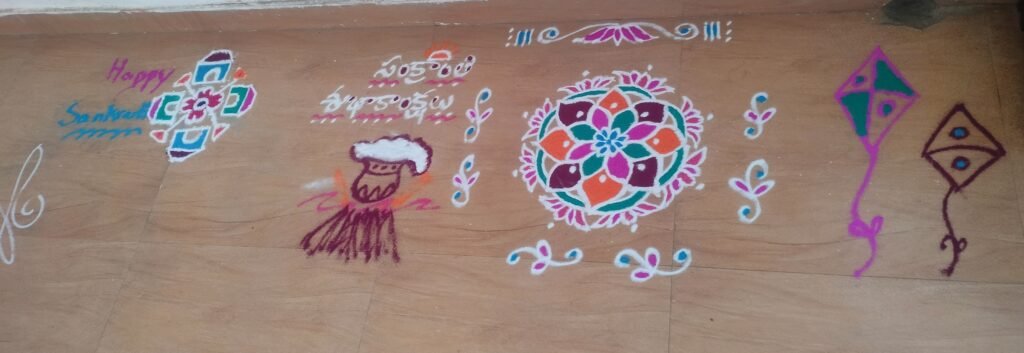
Frequently Asked Questions
India, Rangoli have been originated from India
Rangoli is drawn upon the ground or floor.
Rangoli are majorly drawn during Diwali festive, but now it’s made on all festivals
It’s believed rangoli art was invented 5,000 years ago during the Aryan period.
About the Author

